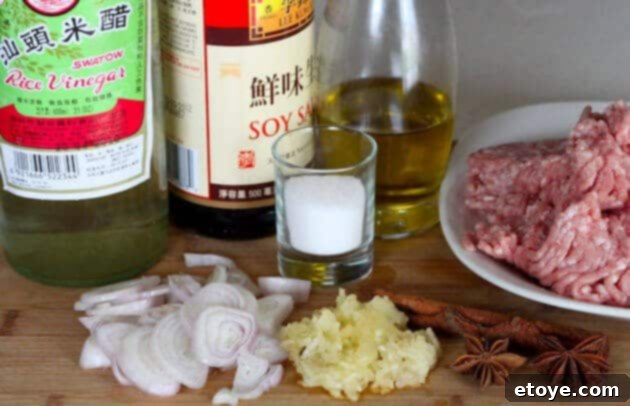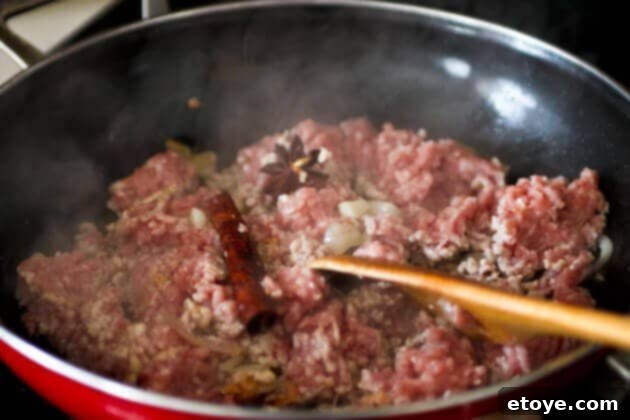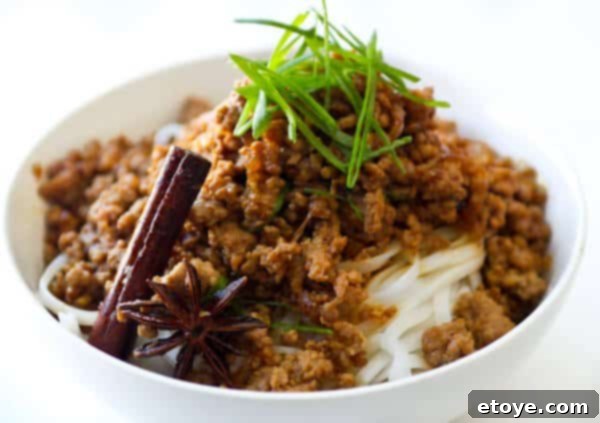Savor the Soul: Mastering Authentic Taiwanese Braised Pork Noodles (Lo Ba)
Embark on a culinary journey to Taiwan with this quintessential comfort food: Braised Pork Noodles, affectionately known as Lo Ba (滷肉麵). This dish isn’t just a meal; it’s a warm embrace in a bowl, a staple that graces tables across Taiwan, from bustling night markets to cozy family kitchens. Lo Ba, quite literally meaning “stewed meat” in Taiwanese, perfectly encapsulates the essence of this dish – tender, slow-cooked pork infused with an irresistible aromatic sauce, served generously over springy noodles. The magic truly begins as the rich aroma of star anise and cinnamon fills your home, promising an authentic Taiwanese flavor experience that’s both deeply satisfying and wonderfully memorable.
This simplified recipe is designed to bring the comforting flavors of Taiwan directly into your kitchen, without requiring hours of complex preparation. In just a few easy steps, you can create a dish that’s destined to become a cherished family favorite. The beauty of Lo Ba lies in its harmonious blend of savory, slightly sweet, and umami notes, creating a flavor profile that is both complex and approachable. Whether you’re new to Taiwanese cuisine or looking to recreate a beloved classic, this recipe offers a straightforward path to culinary success, ensuring a delicious outcome that will delight your palate and warm your soul. Prepare to fall in love with the comforting magic of Taiwanese Braised Pork Noodles, a dish that truly embodies the heart of Taiwanese home cooking.
The Heart of Taiwanese Comfort: Unpacking Lo Ba’s Rich Heritage
Taiwanese Braised Pork, or Lo Ba (滷肉), is more than just a dish; it’s a cornerstone of Taiwanese culinary identity, deeply woven into the fabric of daily life. This beloved staple, often served over rice as Lu Rou Fan or with noodles as Lu Rou Mian, represents generations of comfort food tradition. The art of Lo Ba lies in the slow braising process, which transforms humble cuts of pork – typically pork belly or ground pork – into incredibly tender, melt-in-your-mouth morsels bathed in a rich, glossy sauce. This sauce, a masterful blend of soy sauce, rice wine, sugar, and an aromatic symphony of spices, is what truly defines the dish, offering a delicate balance of savory, sweet, and umami.
The culinary philosophy behind Lo Ba is rooted in simplicity and depth of flavor. Ingredients are often straightforward, but their combination and cooking method create an extraordinary richness. The inclusion of traditional Chinese spices like star anise and cinnamon stick is paramount, as they impart the dish with its signature fragrant warmth and subtle complexity, distinguishing it from other braised pork preparations. These spices, along with garlic and shallots, build a foundational layer of aroma that permeates the pork as it slowly stews. This extended cooking time allows the flavors to fully meld and deepen, resulting in a sauce that is both intensely flavorful and incredibly comforting. It’s this dedication to patient preparation that makes Lo Ba a dish that truly nourishes both body and soul, inviting everyone to experience a taste of genuine Taiwanese hospitality and culinary heritage.

Crafting the Perfect Lo Ba: Essential Ingredients and Flavor Foundations
The secret to a truly exceptional Taiwanese Braised Pork Noodles (Lo Ba) lies not in overly complex techniques, but in the careful selection and thoughtful preparation of key ingredients. Each component plays a vital role in building the dish’s signature deep, savory, and aromatic profile. Let’s delve into what makes each ingredient essential for achieving that authentic Taiwanese taste.
- Ground Pork: While traditional Lo Ba often uses diced pork belly for its luscious fat content, ground pork offers a fantastic, quicker alternative without sacrificing much flavor. Opt for ground pork with a good fat-to-lean ratio (around 80/20) to ensure the sauce has enough richness and the meat remains tender. The smaller pieces of ground pork also absorb the braising liquid more effectively, resulting in a more flavorful bite with every spoonful.
- Shallots (or Onion) & Garlic: These aromatic vegetables form the cornerstone of flavor. Shallots, with their delicate sweetness and milder pungency compared to onions, are preferred for their nuanced contribution. When sautéed until fragrant, they release sweet, caramelized notes that provide a perfect counterpoint to the savory pork. Minced garlic adds a sharp, pungent kick, balancing the richness and depth of the dish.
- Star Anise & Cinnamon Stick: These are the undisputed stars of the spice blend, imparting Lo Ba with its distinctive, warm, and subtly sweet aroma. Star anise offers a licorice-like flavor, while cinnamon provides a comforting, woody sweetness. Together, they create an aromatic foundation that is unmistakably Taiwanese. Ensure they are whole to allow their essences to slowly infuse into the braising liquid.
- Soy Sauce: The backbone of the savory flavor, soy sauce contributes saltiness, umami, and a beautiful deep color to the sauce. Using a good quality light or regular soy sauce is key, as it provides the necessary depth without overpowering the other delicate flavors.
- Rice Vinegar: A splash of rice vinegar is crucial for balancing the richness of the pork and the saltiness of the soy sauce. Its mild acidity brightens the overall flavor profile, adding a subtle tang that prevents the dish from feeling heavy and enhances its complexity.
- Sugar: Sugar plays a multifaceted role in Lo Ba. It caramelizes slightly during the cooking process, contributing to the glossy texture and inviting dark hue of the sauce. More importantly, it balances the savory and tangy elements, adding a touch of sweetness that is characteristic of many Taiwanese dishes and makes the overall flavor incredibly well-rounded and appealing.
By understanding the contribution of each ingredient, you’re not just following a recipe; you’re mastering the art of building complex and harmonious flavors that truly define authentic Taiwanese Braised Pork Noodles. Each component works in concert to create a dish that is both deeply satisfying and exquisitely balanced.



Taiwanese Braised Pork Noodles (Lo Ba) Recipe
A simplified take on a classic, this Taiwanese Braised Pork Noodles recipe, affectionately known as Lo Ba, brings the vibrant flavors of Taiwan directly to your kitchen. While traditional recipes often feature delicate rice noodles, feel free to use any dried pasta you have on hand – spaghetti, linguine, or even angel hair pasta will create a wonderfully satisfying meal, especially when tossed with the rich, aromatic pork. This dish is designed for ultimate comfort and ease, ensuring a delicious experience regardless of your noodle choice. Perfect for a quick weeknight dinner or a cozy weekend meal.
Ingredients
- 1 (10 ounce) package dry rice noodles
- 2 tablespoons cooking oil
- 3 shallots, thinly sliced (or 1/2 small onion)
- 2 whole star anise
- 1 cinnamon stick
- 2 tablespoons garlic, minced
- 1 pound ground pork
- 1/2 cup soy sauce
- 1/2 cup rice vinegar
- 1/4 cup warm water
- 2 tablespoons sugar
Instructions
Prepare a large bowl with approximately 12 ice cubes and 4 cups of cold water to create an ice bath. Set this bowl aside, as it will be essential for stopping the cooking process of the noodles and ensuring their perfect texture.
In a large pot, bring 4 cups of water to a vigorous, rolling boil. Carefully add the dry rice noodles to the boiling water and cook for exactly 2 minutes. Immediately remove the pot from the heat and allow the noodles to continue steeping in the hot water for an additional 2 minutes. This brief steeping period helps them soften perfectly. Without delay, drain the noodles thoroughly in a colander, then immediately transfer them into the prepared ice bath. This abrupt cooling will halt the cooking process, preventing the noodles from becoming overcooked or mushy. Let them cool for just 1 minute in the ice bath, then drain again completely and set aside.
In a separate medium-sized mixing bowl, combine the soy sauce, rice vinegar, warm water, and sugar. Whisk these ingredients together vigorously until the sugar is completely dissolved and all components are well integrated. This mixture will become your flavorful, aromatic braising liquid for the pork.
Heat a large frying pan or a deep sauté pan over medium-high heat. Once the pan is sufficiently hot, add the cooking oil. Immediately add the thinly sliced shallots (or chopped onion), minced garlic, whole star anise, and the cinnamon stick. Sauté these aromatics for approximately 30 seconds, stirring constantly, until they become wonderfully fragrant and slightly softened. Next, add the ground pork to the pan. Using a spatula or wooden spoon, break the meat into small, even pieces and cook, stirring occasionally, until it is thoroughly browned on all sides and no pink remains. This browning step is crucial for developing deep, rich flavors. Once the pork is fully cooked, pour in the prepared soy-vinegar mixture. Bring the liquid to a gentle simmer, then reduce the heat to medium-low. Allow the mixture to simmer for 5 minutes, giving the flavors ample time to meld beautifully and for the pork to absorb the delicious sauce. Serve the hot braised pork and its rich sauce generously over your previously prepared rice noodles.
Notes
This delightful recipe and accompanying photos are generously shared by Shelisa from the Big2Beautiful blog. Her culinary insights bring this traditional dish to life for home cooks, offering a wonderful resource for authentic flavors.
Serving Suggestions & Creative Variations for Your Lo Ba Experience
While Taiwanese Braised Pork Noodles are undeniably delicious on their own, a few thoughtful additions can elevate your meal to an even more satisfying experience. For a complete and balanced dinner, serve your Lo Ba with a side of freshly steamed broccoli, its vibrant green and crisp texture offering a refreshing contrast to the rich pork. Other excellent companions include quick-blanched bok choy, gai lan (Chinese broccoli), or a simple cucumber salad dressed with a light vinaigrette.
For those who love to customize, consider these variations: a sprinkle of chopped fresh cilantro adds a burst of herbaceous freshness, while a dollop of chili garlic sauce can introduce a delightful kick of heat. A perfectly jammy, soft-boiled egg (marinated in a little soy sauce for extra flavor) is a classic accompaniment, adding creamy richness. You can also experiment with different types of noodles; while rice noodles are called for, egg noodles, ramen, or even spaghetti can serve as excellent conduits for the savory sauce. Don’t hesitate to adjust the sweetness or saltiness of the sauce to your preference, ensuring each bowl of Lo Ba is perfectly tailored to your taste. This adaptability is part of what makes Lo Ba a truly versatile and beloved dish.
Conclusion: Bring the Flavors of Taiwan Home
This journey into crafting Taiwanese Braised Pork Noodles (Lo Ba) is more than just following a recipe; it’s an invitation to experience the warmth and comfort of Taiwanese home cooking. With its tender, aromatic pork and perfectly seasoned noodles, Lo Ba offers a deeply satisfying meal that transcends cultural boundaries. The harmonious blend of star anise, cinnamon, soy, and a touch of sweetness creates a culinary masterpiece that is both surprisingly simple to achieve and incredibly rewarding to savor. So gather your ingredients, follow these steps, and prepare to bring the authentic, soul-soothing flavors of Taiwan right into your own kitchen. Your family and friends will thank you for this delightful taste adventure!
